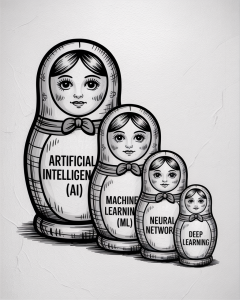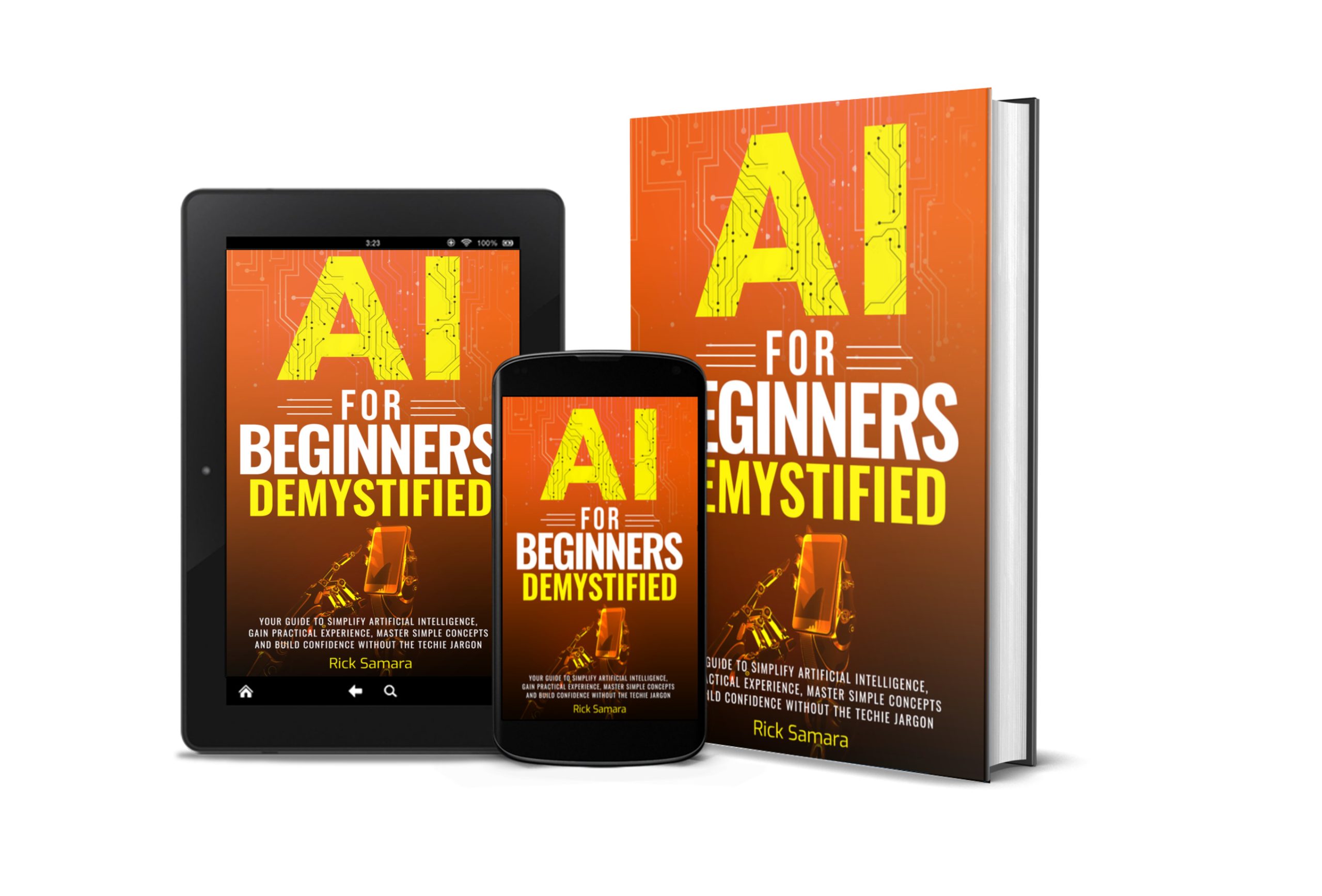In “AI for Beginners Demystified,” Rick Samara sets out to make the complex world of Artificial Intelligence, or AI, easy to understand for readers of all backgrounds. Using humor and engaging storytelling, he shows AI not as confusing technical jargon but as an accessible tool that can improve our daily lives. The book features personal stories, light-hearted comments, and real-life examples to create an inviting story that connects with readers and sparks curiosity about AI.
Rick’s Background in Writing AI for Beginners Demystified
Rick shares a personal story from his time as an Intelligence Analyst in the United States Air Force. Confronted with the challenge of making complex data understandable to others, he developed a talent for breaking down complicated ideas into simple, digestible parts. His experiences form the foundation for AI for Beginners Demystified, which maintains the same clarity and straightforwardness in explaining AI. The main goal is to give readers practical knowledge and the confidence to explore AI applications in their personal and professional lives.
Skepticism Surrounding AI
 AI for Beginners Demystified opens with a discussion on the skepticism that often surrounds AI. The author acknowledges that many people view AI through the lens of fear and confusion, equating it with job loss or a loss of control. He dispels these myths by emphasizing that AI is not a sinister force set to replace humans but rather a companion that can enhance productivity and efficiency. By drawing humorous parallels with past technological revolutions — such as the automobile and the computer — the author demonstrates that skepticism can lead to thoughtful discussions that eventually pave the way for acceptance and innovation.
AI for Beginners Demystified opens with a discussion on the skepticism that often surrounds AI. The author acknowledges that many people view AI through the lens of fear and confusion, equating it with job loss or a loss of control. He dispels these myths by emphasizing that AI is not a sinister force set to replace humans but rather a companion that can enhance productivity and efficiency. By drawing humorous parallels with past technological revolutions — such as the automobile and the computer — the author demonstrates that skepticism can lead to thoughtful discussions that eventually pave the way for acceptance and innovation.
Machine Learning, Neural Networks, Deep Learning and Generative AI Explained in AI For Beginners Demystified
In subsequent chapters, the author demystifies key AI concepts such as Machine Learning, Neural Networks, and Deep Learning. He employs humor and relatable analogies to explain complex algorithms and data processes. For instance, he compares Machine Learning to teaching someone to bake by allowing them to experiment rather than strictly dictating every step. It is a playful yet effective way to convey the essence of Machine Learning, learning from experience rather than following detailed instructions.
Networks, and Deep Learning. He employs humor and relatable analogies to explain complex algorithms and data processes. For instance, he compares Machine Learning to teaching someone to bake by allowing them to experiment rather than strictly dictating every step. It is a playful yet effective way to convey the essence of Machine Learning, learning from experience rather than following detailed instructions.
He concludes this section of AI for Beginners Demystified with an overview of Generative AI. Generative AI creates content such as stories, articles, and even books. It can generate pictures, images, videos from scratch, and it can also produce music. These systems mainly rely on neural networks, which mimic how our brains work. Deep learning, a key part of this process, uses layers of these networks to analyze large amounts of data. So, when a generative AI studies many novels or examines millions of images, it starts recognizing patterns and styles. The result? It can produce something new and unique that makes it surprisingly human. Generative AI is truly fascinating!
Theory into Practice
To further solidify understanding, Rick shares personal stories of how he uses AI tools in his company, E-Internet Marketing Services. By integrating these insights, he successfully connects theoretical concepts with practical applications. Readers see how AI can be beneficial in real-world scenarios, encouraging confidence in their abilities to leverage this technology.
AI Applications/Chatbots Explained in AI for Beginners Demystified
 The heart of the book lies in the examples of AI applications that the author interacts with daily. From virtual assistants like Siri and Alexa, which exhibit advanced learning capabilities, to smart home devices that create a more convenient living environment, the author elaborates on how these technologies enhance our lives. He highlights his experiences with smartphone applications, showing how AI makes tasks like photo editing and online shopping seamless and personalized.
The heart of the book lies in the examples of AI applications that the author interacts with daily. From virtual assistants like Siri and Alexa, which exhibit advanced learning capabilities, to smart home devices that create a more convenient living environment, the author elaborates on how these technologies enhance our lives. He highlights his experiences with smartphone applications, showing how AI makes tasks like photo editing and online shopping seamless and personalized.
One particularly amusing example is his story about gifting his elderly mother an Amazon Echo device. Initially skeptical, she quickly embraced technology, finding joy in ordering her necessities and controlling her home environment with simple voice commands. Not only does this narrative bring warmth to the discussion, but it also underscores the real-world benefits of AI—it serves to empower individuals, regardless of age or technical expertise.
In further chapters, Rick dives into the specific AI tools he employs in his business, illustrating how they streamline his services and improve client interactions. He discusses chatbots that facilitate customer engagement, predictive analytics that inform marketing strategies, and tools that automate routine tasks. Each example is laced with humor as he reflects on the learning curves and challenges associated with adopting these technologies. By sharing his genuine enthusiasm for these tools, he motivates readers to explore AI’s potential in their ventures.
As you flip through the pages, expect unexpected transitions, such as a whimsical poem that smoothly introduces new chapters, infusing the text with rhythm and creativity. The author doesn’t shy away from the quirky side of AI—like the time their AI assistant hilariously malfunctioned, leading to a series of comical misunderstandings that set the stage for a deeper discussion on bias in technology.
He also highlights the changing nature of the job market as AI becomes more widespread across various industries. Instead of fearing obsolescence, he urges readers to see AI as an opportunity to adapt and advance their careers. This perspective aligns with reports about the future of work, which predict a net increase of millions of jobs due to the rise of AI.
With a warm and engaging voice, the author shares captivating personal stories that weave seamlessly into the narrative, illustrating the trials and triumphs of navigating the AI landscape. You’ll chuckle at the author’s mishaps and triumphs, feeling as though you’re sharing a cup of coffee with a friend who just happens to be an AI enthusiast.
Book Summary and Conclusion
AI for Beginners Demystified is more than a practical guide; it is an invitation to embrace curiosity and explore the vast landscape of Artificial Intelligence. The author’s personal touch, combined with humorous anecdotes, makes the daunting subject of AI approachable and enjoyable. By the end of the book, readers are equipped not only with foundational knowledge of AI but also with the motivation to engage with this transformative technology in meaningful ways. The author offers additional value by providing some excellent, free ways to continue expanding the reader’s knowledge of AI.
In conclusion, the author’s talent for storytelling, combined with his relatable experiences, crafts an engaging narrative that leaves readers feeling confident about exploring the world of AI. “AI for Beginners Demystified” reminds us that technology doesn’t have to be feared or misunderstood; instead, it can become our greatest ally as we navigate the complexities of modern life. Whether readers are casual learners or professional practitioners, this comprehensive yet lighthearted look at Artificial Intelligence offers something for everyone.


